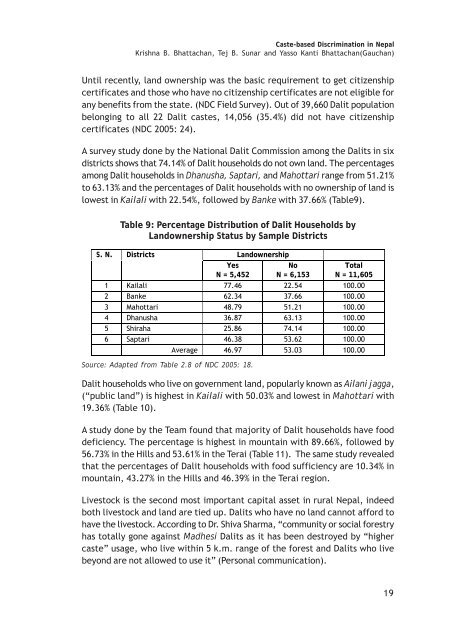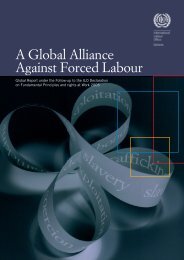Caste-based discrimination in Nepal - International Dalit Solidarity ...
Caste-based discrimination in Nepal - International Dalit Solidarity ...
Caste-based discrimination in Nepal - International Dalit Solidarity ...
You also want an ePaper? Increase the reach of your titles
YUMPU automatically turns print PDFs into web optimized ePapers that Google loves.
<strong>Caste</strong>-<strong>based</strong> Discrim<strong>in</strong>ation <strong>in</strong> <strong>Nepal</strong><br />
Krishna B. Bhattachan, Tej B. Sunar and Yasso Kanti Bhattachan(Gauchan)<br />
Until recently, land ownership was the basic requirement to get citizenship<br />
certificates and those who have no citizenship certificates are not eligible for<br />
any benefits from the state. (NDC Field Survey). Out of 39,660 <strong>Dalit</strong> population<br />
belong<strong>in</strong>g to all 22 <strong>Dalit</strong> castes, 14,056 (35.4%) did not have citizenship<br />
certificates (NDC 2005: 24).<br />
A survey study done by the National <strong>Dalit</strong> Commission among the <strong>Dalit</strong>s <strong>in</strong> six<br />
districts shows that 74.14% of <strong>Dalit</strong> households do not own land. The percentages<br />
among <strong>Dalit</strong> households <strong>in</strong> Dhanusha, Saptari, and Mahottari range from 51.21%<br />
to 63.13% and the percentages of <strong>Dalit</strong> households with no ownership of land is<br />
lowest <strong>in</strong> Kailali with 22.54%, followed by Banke with 37.66% (Table9).<br />
Table 9: Percentage Distribution of <strong>Dalit</strong> Households by<br />
Landownership Status by Sample Districts<br />
S. N. Districts<br />
Yes<br />
N = 5,452<br />
Landownership<br />
No<br />
N = 6,153<br />
Total<br />
N = 11,605<br />
1 Kailali 77.46 22.54 100.00<br />
2 Banke 62.34 37.66 100.00<br />
3 Mahottari 48.79 51.21 100.00<br />
4 Dhanusha 36.87 63.13 100.00<br />
5 Shiraha 25.86 74.14 100.00<br />
6 Saptari 46.38 53.62 100.00<br />
Average 46.97 53.03 100.00<br />
Source: Adapted from Table 2.8 of NDC 2005: 18.<br />
<strong>Dalit</strong> households who live on government land, popularly known as Ailani jagga,<br />
(“public land”) is highest <strong>in</strong> Kailali with 50.03% and lowest <strong>in</strong> Mahottari with<br />
19.36% (Table 10).<br />
A study done by the Team found that majority of <strong>Dalit</strong> households have food<br />
deficiency. The percentage is highest <strong>in</strong> mounta<strong>in</strong> with 89.66%, followed by<br />
56.73% <strong>in</strong> the Hills and 53.61% <strong>in</strong> the Terai (Table 11). The same study revealed<br />
that the percentages of <strong>Dalit</strong> households with food sufficiency are 10.34% <strong>in</strong><br />
mounta<strong>in</strong>, 43.27% <strong>in</strong> the Hills and 46.39% <strong>in</strong> the Terai region.<br />
Livestock is the second most important capital asset <strong>in</strong> rural <strong>Nepal</strong>, <strong>in</strong>deed<br />
both livestock and land are tied up. <strong>Dalit</strong>s who have no land cannot afford to<br />
have the livestock. Accord<strong>in</strong>g to Dr. Shiva Sharma, “community or social forestry<br />
has totally gone aga<strong>in</strong>st Madhesi <strong>Dalit</strong>s as it has been destroyed by “higher<br />
caste” usage, who live with<strong>in</strong> 5 k.m. range of the forest and <strong>Dalit</strong>s who live<br />
beyond are not allowed to use it” (Personal communication).<br />
19

















